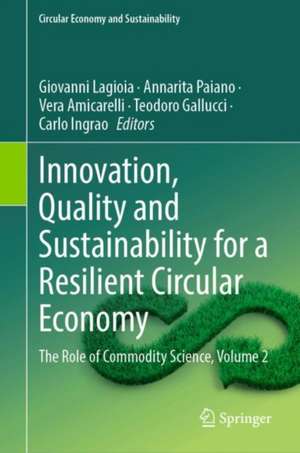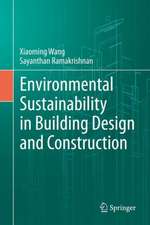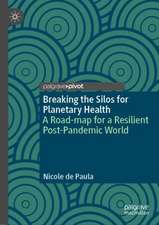Innovation, Quality and Sustainability for a Resilient Circular Economy: The Role of Commodity Science, Volume 2: Circular Economy and Sustainability
Editat de Giovanni Lagioia, Annarita Paiano, Vera Amicarelli, Teodoro Gallucci, Carlo Ingraoen Limba Engleză Hardback – 27 apr 2024
Under this perspective, the book highlights the central role that Commodity Science can play, also considering the multiple possibilities of interacting with other relevant research sectors, like food production and packaging, engineering, environmental science, organization, management, decision science, and social science, so enabling valorization and maximization. These interactions will appeal to academics, producers, decision- and policymakers, and other stakeholders.
Thus, this book has a multidisciplinary holistically integrated approach to Commodity Science that contributes to enhancing the current literature and knowledge.
| Toate formatele și edițiile | Preț | Express |
|---|---|---|
| Hardback (2) | 1231.47 lei 3-5 săpt. | |
| Springer Nature Switzerland – 27 apr 2024 | 1231.47 lei 3-5 săpt. | |
| Springer International Publishing – 24 feb 2024 | 1477.52 lei 38-44 zile |
Preț: 1231.47 lei
Preț vechi: 1501.79 lei
-18% Nou
Puncte Express: 1847
Preț estimativ în valută:
235.65€ • 246.85$ • 195.30£
235.65€ • 246.85$ • 195.30£
Carte disponibilă
Livrare economică 18 martie-01 aprilie
Preluare comenzi: 021 569.72.76
Specificații
ISBN-13: 9783031552052
ISBN-10: 3031552059
Pagini: 391
Ilustrații: XXII, 391 p. 51 illus., 34 illus. in color.
Dimensiuni: 155 x 235 mm
Greutate: 0.84 kg
Ediția:2024
Editura: Springer Nature Switzerland
Colecția Springer
Seria Circular Economy and Sustainability
Locul publicării:Cham, Switzerland
ISBN-10: 3031552059
Pagini: 391
Ilustrații: XXII, 391 p. 51 illus., 34 illus. in color.
Dimensiuni: 155 x 235 mm
Greutate: 0.84 kg
Ediția:2024
Editura: Springer Nature Switzerland
Colecția Springer
Seria Circular Economy and Sustainability
Locul publicării:Cham, Switzerland
Cuprins
Part I. Waste management: Innovation and Quality.- Chapter 1. Development of an innovative controlled drying technology for the recovery of waste from the wine chain in a circular-economy perspective.- Chapter 2. Reduction of food waste and donations of surplus food in retail stores: A survey proposal.- Chapter 3. Enhancement of waste from the agri-food chain as innovative ingredients for the formulation of functional foods and their impact in chronic kidney disease.- Part II. Waste management: Circular economy and sustainability.- Chapter 4. The study of variables that influence the implementation of a waste cycle tracking system: a literature review.- Chapter 5. Quantification of fugitive methane emissions from landfills: an open issue.- Chapter 6. Sustainable organic waste management in small communities: evidence from life cycle-based evaluations.- Chapter 7. Valorisation of by-product and industry waste for date palm fruit by recovering bioactive molecules and possible applications: a circular economy model.- Chapter 8. Valorisation of pomegranate waste and by-products for new models of circular economy.- Chapter 9. Carbon, Water and Energy Footprint. A sustainability assessment for fruit & vegetable losses in Italy.- Chapter 10. Green technologies and LCA for the analysis of bioactive compounds in wheat husk: an integrated study for sustainability assessment.- Chapter 11. Modelling the leather industry waste from the circular economy perspective. A depth-review.- Chapter 12. Application of the MFA methodology for the analysis of paper and cardboard waste in Italy and a focus on the waste management in Apulia.- Chapter 13. Material Flow Analysis and Life Cycle Assessment of Waste Electrical and Electronic Equipment in a Regional Circular Economy Scenario.- Chapter 14. Closing the cycle by reusing treated wastewater: the role of Prato in the European debate on Circular Economy.- Part III. Circular economy and sustainability issues in several sectors: Energy.-Chapter 15. Natural gas supply in Italy: analysis and perspectives.- Chapter 16. The agro-photovoltaic sector as a possible implementation tool in Sicilian energy transition.- Chapter 17. Redevelopment of industrial brownfields through green hydrogen: evolution and criticalities.- Chapter 18. Life Cycle Assessment and Life Cycle Costing of a unitized regenerative fuel cell stack: a preliminary study.- Part IV. Circular economy and sustainability issues in several sectors: Leather and textile.- Chapter 19. A Hypothesis of a Lean Warehouse Design for an Italian Textile-Apparel Company.- Chapter 20. Textile industry between past and future in the in the New Museum of Commodity Science.- Chapter 21. Production and consumption trends in the European textile sector and main sustainability challenges.- Chapter 22. The future of the Italian tanning industry considering the recent geopolitical crisis.- Chapter 23. Risk assessment and life cycle approach to optimize the sustainability performance of leather products.- Chapter 24. A combined economic-environmental assessment of an innovative chemical formulation for waterproofing applications in the leather manufacturing industry.- Part V. Circular economy and sustainability issues in several sectors: Mobility, Logistics and Transports.- Chapter 25. Mobility Environmental Profile in the Framework of a Research Project: The “CRESTING” Case.- Chapter 26. University students and mobility. A sustainability analysis.- Chapter 27. Life Cycle Costing in the maritime sector: the case of the extraordinary maintenance of a Roll-on/Roll-off ferry.- Chapter 28. The last-mile delivery process from a life cycle perspective.- Part VI. Circular economy and sustainability issues in several sectors: Technical materials and products.- Chapter 29. Concerns deriving from the sand business and potential substitutes for a sustainable construction sector.- Chapter 30. Reshoring and nearshoring of resources towards making the manufacturing chain of the Italian ceramic industry more resilient and sustainable.- Chapter 31. Definition of indicators relating to the extraction of minerals used in the ceramic sector for LCA.- Chapter 32. Personal Protective Equipment recycling scenarios for the production of reinforced bituminous conglomerates.- Chapter 33. Environmental performance and efficiency in the semiconductor fabrication sector.- Chapter 34. The recovery of materials and management at the end-of-life of ships. Models and strategies for a Critical Raw Materials Circular Market in Europe.- Part VII. Quality, circular economy, and sustainability: a miscellaneous of general facts.- Chapter 35. Entropic Limits of Circular Economy.- Chapter 36. Circular Bioeconomy: An analysis of operational principles and limits.- Chapter 37. Comparison and Contrast between Corporate Social Responsibility and Corporate Social Innovation.- Chapter 38. Transition to Social Organizational Life Cycle Assessment: connections with social responsibility tools.- Chapter 39. A new approach to improve sustainability: the role of Organizational Life Cycle Assessment (O-LCA).- Chapter 40. The proposal for the new Corporate Sustainability Reporting Directive (CSRD): towards better environmental data in sustainability reporting.- Chapter 41. ESG indicators and SME: towards a simplified framework for sustainability reporting.- Chapter 42. Women entrepreneurship and new business models for a quality production of Aloe Vera in Jordan.- Chapter 43. Sustainability standards and certifications for the healthcare sector: A literature review on social, economic, and environmental indicators.- Chapter 44. ISO 9001 certification of the Specialization Schools of the Health Area of the University of Padova.- Chapter 45. European University Alliances and good quality assurance practice.- Chapter 46. The inclusion of gender diversity in Italian universities: main priorities and critical issues.- Chapter 47. Patent box as a tax relief tool for companies operating in circular economy context.- Chapter 48. Industrial symbiosis in Sicily: perspectives and criticalities
Notă biografică
Giovanni Lagioia (University of Bari Aldo Moro, Bari, Italy) is a full professor at the University of Bari Aldo Moro. He has a PhD in Commodity Science. He is also the Head of the Department of Economics, Management and Business Law at the University of Bari Aldo Moro. He teaches Commodity Science, Environmental Strategies for Circular Economy, and Waste Management. His main research topics include Bioenergy, the End-of-Life Management, Material Flow Analysis, Life Cycle Thinking, Input-Output Analysis, and Circular Economy.
Annarita Paiano (University of Bari Aldo Moro, Bari, Italy) holds a master’s degree in Economics and has a PhD. She is currently an associate professor of Commodity Science, Technology, Innovation and Sustainable Production at the University of Bari Aldo Moro. She is also an Editorial Board Member and reviewer of international journals such as MPDI, Elsevier, Springer and others. She uses LCA,MFA, Carbon Footprint, and Water Footprint-based Approaches.
Vera Amicarelli (University of Bari Aldo Moro, Bari, Italy) is an associate professor at University of Bari Aldo Moro. She has a PhD in Commodity Science. She teaches Industrial Ecology, Quality, Environment and Sustainability and Resource and Waste Management. Her main research interests focus on Material Flow Analysis, Natural Resources and Environmental Management and Circular Economy. Since 1996, she has been a member of the Italian Commodity Science Academy (AISME).
Teodoro Gallucci (University of Bari Aldo Moro, Bari, Italy) is an associate professor at University of Bari Aldo Moro. He holds a PhD in Commodity Science. His main research topics concern the study and analysis of production processes through the methodology of life cycle thinking, such as Life Cycle Assessment (LCA) applied to different economic sectors.
Carlo Ingrao (University of Bari Aldo Moro, Bari, Italy) is a tenure-track assistant professor in “Commodity Science” at the University of Bari Aldo Moro. He has an MSc degree in “Engineering for the Environment and the Territory” from the University of Catania and a PhD in “Civil Infrastructure for the Territory” from Kore University of Enna, Italy and in “Geotechnical Engineering” from University of Catania, Italy. His research interests include Development of Life-Cycle Energy and Environmental Assessments in the field of Commodity Sciences and in related others.
Annarita Paiano (University of Bari Aldo Moro, Bari, Italy) holds a master’s degree in Economics and has a PhD. She is currently an associate professor of Commodity Science, Technology, Innovation and Sustainable Production at the University of Bari Aldo Moro. She is also an Editorial Board Member and reviewer of international journals such as MPDI, Elsevier, Springer and others. She uses LCA,MFA, Carbon Footprint, and Water Footprint-based Approaches.
Vera Amicarelli (University of Bari Aldo Moro, Bari, Italy) is an associate professor at University of Bari Aldo Moro. She has a PhD in Commodity Science. She teaches Industrial Ecology, Quality, Environment and Sustainability and Resource and Waste Management. Her main research interests focus on Material Flow Analysis, Natural Resources and Environmental Management and Circular Economy. Since 1996, she has been a member of the Italian Commodity Science Academy (AISME).
Teodoro Gallucci (University of Bari Aldo Moro, Bari, Italy) is an associate professor at University of Bari Aldo Moro. He holds a PhD in Commodity Science. His main research topics concern the study and analysis of production processes through the methodology of life cycle thinking, such as Life Cycle Assessment (LCA) applied to different economic sectors.
Carlo Ingrao (University of Bari Aldo Moro, Bari, Italy) is a tenure-track assistant professor in “Commodity Science” at the University of Bari Aldo Moro. He has an MSc degree in “Engineering for the Environment and the Territory” from the University of Catania and a PhD in “Civil Infrastructure for the Territory” from Kore University of Enna, Italy and in “Geotechnical Engineering” from University of Catania, Italy. His research interests include Development of Life-Cycle Energy and Environmental Assessments in the field of Commodity Sciences and in related others.
Textul de pe ultima copertă
This book is the second volume of a selection of the best papers presented at the XXX National Conference of Commodity Science held in Bari, Italy on 27–28th October, 2022. It is designed to help advance the knowledge and application of Commodity Science in innovation, quality, and sustainability principles and goals. Furthermore, it provides support in confronting the current environmental and socioeconomic challenges and contributes to addressing and solving those concerns in a circular economy context.
Under this perspective, the book highlights the central role that Commodity Science can play, also considering the multiple possibilities of interacting with other relevant research sectors, like food production and packaging, engineering, environmental science, organization, management, decision science, and social science, so enabling valorization and maximization. These interactions will appeal to academics, producers, decision- and policymakers, and other stakeholders.
Thus, this book has a multidisciplinary holistically integrated approach to Commodity Science that contributes to enhancing the current literature and knowledge.
Thus, this book has a multidisciplinary holistically integrated approach to Commodity Science that contributes to enhancing the current literature and knowledge.
Caracteristici
Provides quantitative tools for addressing environmental management Advances the multidisciplinary holistically integrated approach Advances application in Circular Economy and Innovation

































